36 Hours
36 Hours in Mumbai

Mumbai appears as much a dream as a city. Sprinkled with the stardust of Bollywood, the Hindi-language film industry that bases itself here, and studded with billionaires, India’s hyperkinetic metropolis, known as Bombay until 1995, feels like a place where anything is possible. But over the years, the city’s reality has been one of crumbling infrastructure, unmoving traffic and unending slums. Amid tight pandemic lockdowns, Mumbai turned into one of the world’s great construction sites, trying to remake itself with new towers, subway lines and bridges. Take in the dizzying juxtapositions — while discovering experimental performances in former textile mills and serene, ancient caves a short drive from the urban chaos — in a city guaranteed to look different again the next time you visit.
Recommendations
- Chhatrapati Shivaji Maharaj Vastu Sangrahalaya, a sprawling and immaculately kept museum, houses a trove of Hindu, Jain and Buddhist sculptures.
- The Bombay Poetry Crawl offers a walking tour through one of Mumbai’s most rapidly gentrifying areas and traces the city’s working-class roots through poetry.
- The Kanheri Caves are an ancient Buddhist complex of more than 100 caves, some dating back as far as 2,000 years, in Sanjay Gandhi National Park. Some of the caves have pillared prayer halls and serene, carved Buddhist deities.
- G5A, an arts center housed in part of a former textile mill, hosts music, film screenings, poetry readings and performances.
- The Afghan Church, formally known as the Church of St. John the Evangelist, is a newly restored 19th-century house of worship that serves as a poignant memorial for fallen Indian and British soldiers.
- Mani Bhavan, the former home of Mohandas K. Gandhi, is now a museum that preserves details of his spartan life, underscoring his emphasis on self-reliance.
- Moghal Masjid, a Shiite mosque built in 1860, is known for its intricate blue tile work.
- Hasnabad Dargah, known as Mumbai’s Taj Mahal for its resemblance to that celebrated monument, is a milky-white mausoleum that evokes calm in the middle of the city.
- Magen David Synagogue is a large historic temple, painted sky blue, in the Byculla neighborhood.
- Stroll by murals of Bollywood stars in Bandra, a coastal neighborhood of old Portuguese bungalows and celebrity homes.
- Masque is a high-end restaurant that reinvents traditional Indian dishes in modern, surprising ways over a nine-course tasting menu.
- Kala Ghoda Cafe serves healthy breakfasts, including spicy egg dishes.
- Swati Snacks, a Mumbai institution, offers street-food classics and traditional favorites in a bright, clean setting.
- Aaswad Upahar and Mithai Griha is a popular, no-frills restaurant in the Dadar neighborhood that offers a mango-themed thali (a platter filled with various small dishes) in April and May, when the fruit is in season.
- Bastian at the Top, a sceney rooftop restaurant with lavish décor that includes an indoor swimming pool, is worth a stop to take in the views of the bay over a drink.
- Moonray, a newly opened women’s wear store, brings together immaculate European cuts and handmade embroidery from Mumbai.
- Payal Khandwala sells silk tops, sharply cut suits and trench coats in bold-colored Indian fabric.
- Ogaan showcases a range of local designers whose garments include ornate Indian wedding wear and silk shirts.
- Kitab Khana has a large and well-curated selection of books on Indian literature, politics and Gandhian thought, set in a building that is more than a century old.
- Induri Saree Centre sells glittering, traditional saris in a candy-box-size store.
- The Taj Mahal Palace, an ornate hotel open since 1903, looks over the Arabian Sea and the historic Gateway of India arch. A memorial in the lobby commemorates the terror attack at the hotel in 2008. Rooms start at 23,550 rupees, or about $282.
- Sea Green Hotel, on the curved, lit-up shoreline called the Queen’s Necklace, has basic rooms with gorgeous bay views. Rooms start at around 9,000 rupees.
- The Grand Hotel is a century-old establishment in the city’s historic Ballard Estate district, an area that is also home to one of Mumbai’s best-known Parsi restaurants, Britannia & Co. You can also walk to many of the city’s well-known attractions. Rooms start at around 6,850 rupees.
- Traveling in Mumbai’s packed trains is fast, efficient and an experience like no other. Millions travel on the local trains every year, and vendors and singers walk through compartments (25 rupees for a first-class single ticket). Black-and-yellow cabs, which use meters with fixed rates, and ride-hailing apps like Uber are readily available. Mumbai’s red buses also offer a breezy, scenic and cheap way to get around the city (from 5 rupees per trip).
Itinerary
Friday
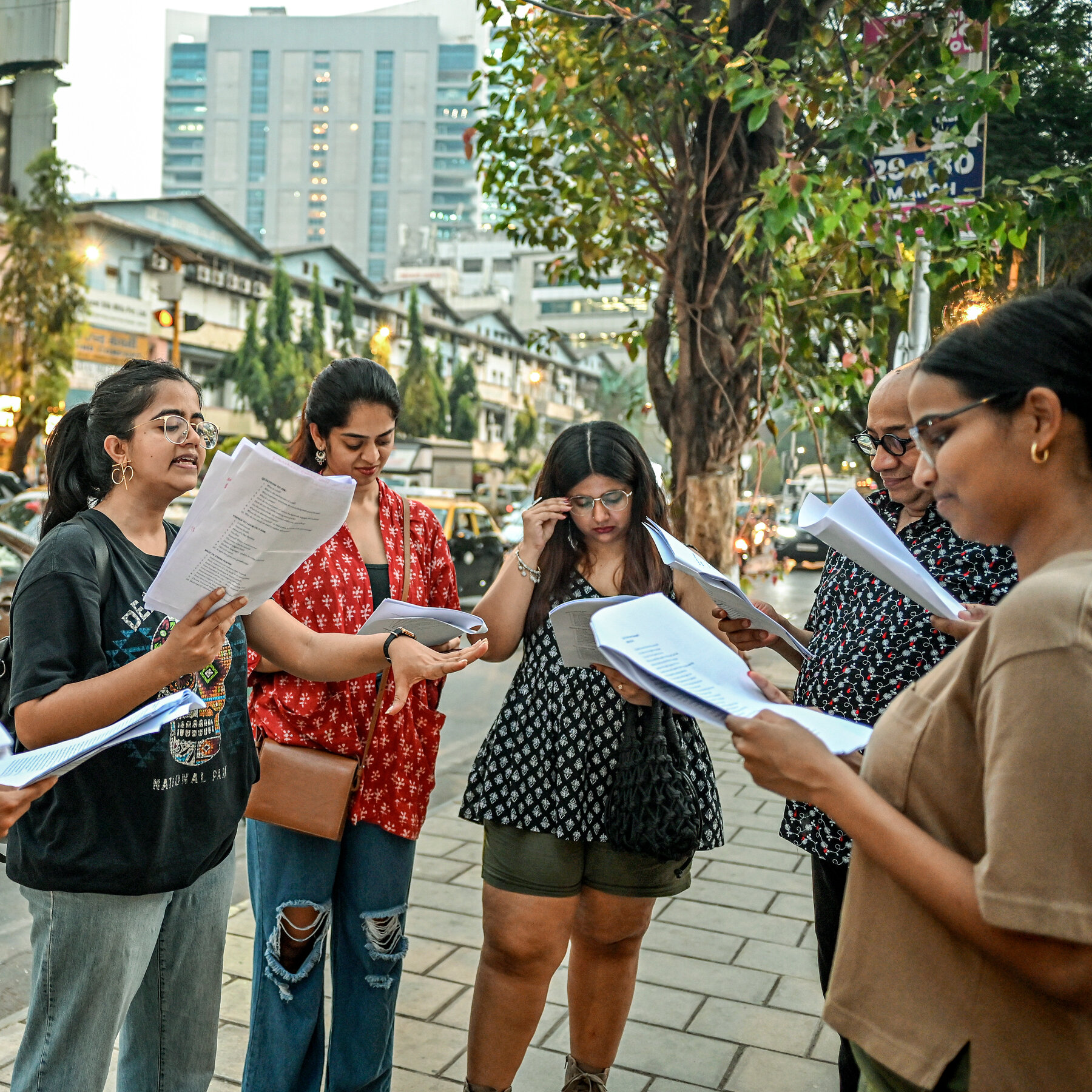
See spindly chimneys rising amid luxury hotels and condos in the jagged skyline of Lower Parel, a rapidly gentrifying precinct in central Mumbai. The chimneys are relics of the area’s former textile mills, which began slowly being redeveloped into malls after a worker strike in the 1980s. Trace Mumbai’s working-class roots here with the writer Saranya Subramanian, who leads the Bombay Poetry Crawl (600 rupees, or about $7), a series of walking tours conducted through the lens of poetry and local history. During the tour, Ms. Subramanian reads poetry by workers and encourages participants to read, too. She leads the tour monthly and also hosts a range of other poetry walks in the city, including one on a local train. Check her Instagram page, @thebombaypoetrycrawl, for scheduling.


Take a car to the nearby G5A, a cultural center housed in a repurposed textile mill compound. Trees grow out of the stone walls of a neighboring former mill, and skyscrapers rise, seemingly by the minute, on the other side. Catch a show at G5A, which hosts edgy art performances, movie screenings and discussions in its small theater, or on its terrace, with the moon glowing through the Mumbai haze. Recent shows include a poetry reading by the Pulitzer Prize-winning author Forrest Gander, along with the celebrated Indian poet Arvind Krishna Mehrotra; Norwegian and Bangalorean jazz bands; and a Kashmiri film. Tickets from 250 to 700 rupees.


Walk next door, still within the mill compound, to the high-ceilinged and warmly lit Masque, a restaurant that reinvents traditional Indian dishes across a nine-course tasting menu (5,200 rupees per person). It takes puran poli and amti, for instance, a sweet, lentil-filled flatbread and side of spicy coconut dal that is often eaten during Mumbai festivals, and remixes it as a bite-size chickpea tart with a hint of jaggery (Indian raw sugar), filled with green peas or crab and topped with coconut foam. Pav, a ubiquitous Mumbai bread bun with a crackly top and slightly sweet, dense interior, acquires a croissant-like, buttery texture here — dip it into a silky morel or lamb curry. Cap off the meal with a popsicle made with unlikely layers of Indian pickle, mulberry and white chocolate. Vegetarian menus available.

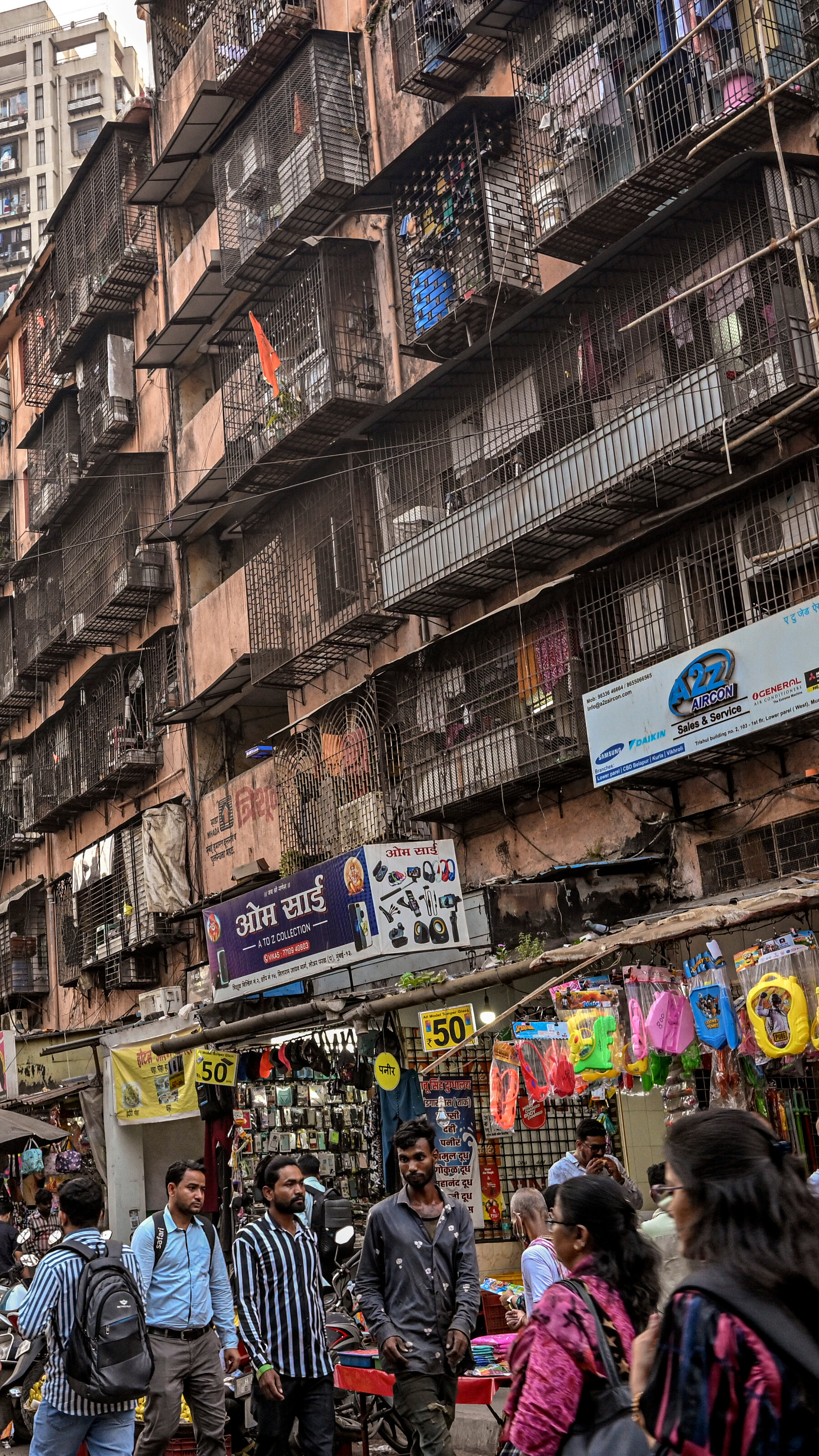
Trace Mumbai’s working-class roots in Lower Parel with the Bombay Poetry Crawl, a series of walking tours conducted through the lens of poetry and local history.
Saturday

Walk through the soft-colored shadows cast by stained-glass windows in the Church of St. John the Evangelist, more commonly known as the Afghan Church, which reopened in March after a two-year renovation. The building, in the leafy Navy Nagar, a naval area at the southern tip of Mumbai, was completed in 1858 and commemorates the more than 4,500 Indian and British soldiers who died during the first Anglo-Afghan war, including in its disastrous retreat from Kabul. The church is also known for multifaith prayers, Indian classical music concerts and a midnight Mass at Christmas. Entry is free.

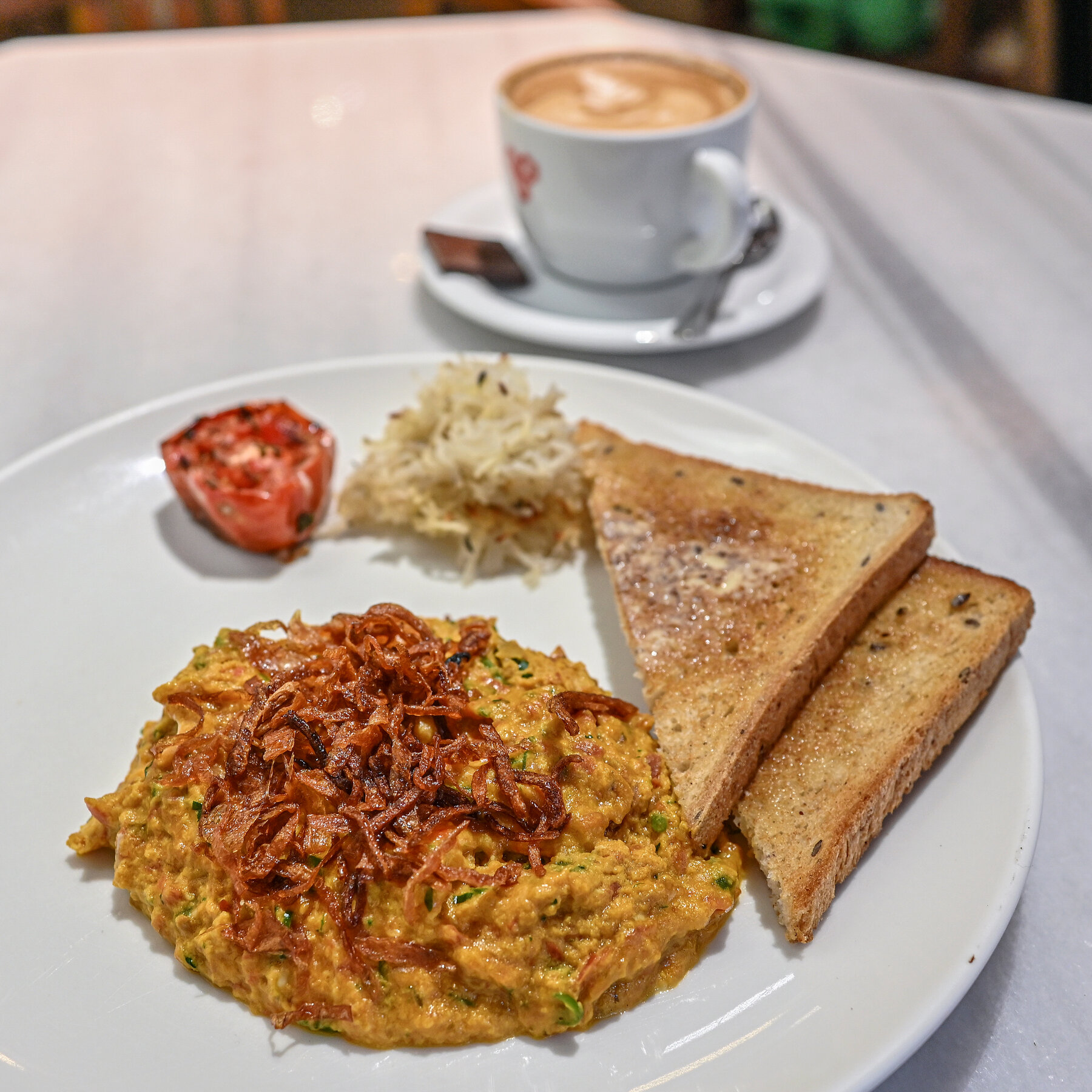
Kala Ghoda Cafe
Dig into a breakfast of akuri, a spicy scrambled egg dish (345 rupees) that is traditional in India’s Parsi community, at Kala Ghoda Cafe, in the Kala Ghoda neighborhood. Then walk to the sprawling Chhatrapati Shivaji Maharaj Vastu Sangrahalaya, a museum with manicured lawns and a Gothic-style building topped with a bulbous dome. As part of “Ancient Sculptures,” showing through October, chiseled Greek gods and Egyptian deities from the British Museum and the J. Paul Getty Museum share space with Assyrian gods from CSMVS’s permanent collection. The museum’s permanent galleries are a trove of Hindu, Buddhist and Jain sculptures and also feature artifacts from the ancient Indus Valley civilization. Tickets, 150 rupees for Indian nationals; 700 rupees for foreigners.

Kala Ghoda Cafe
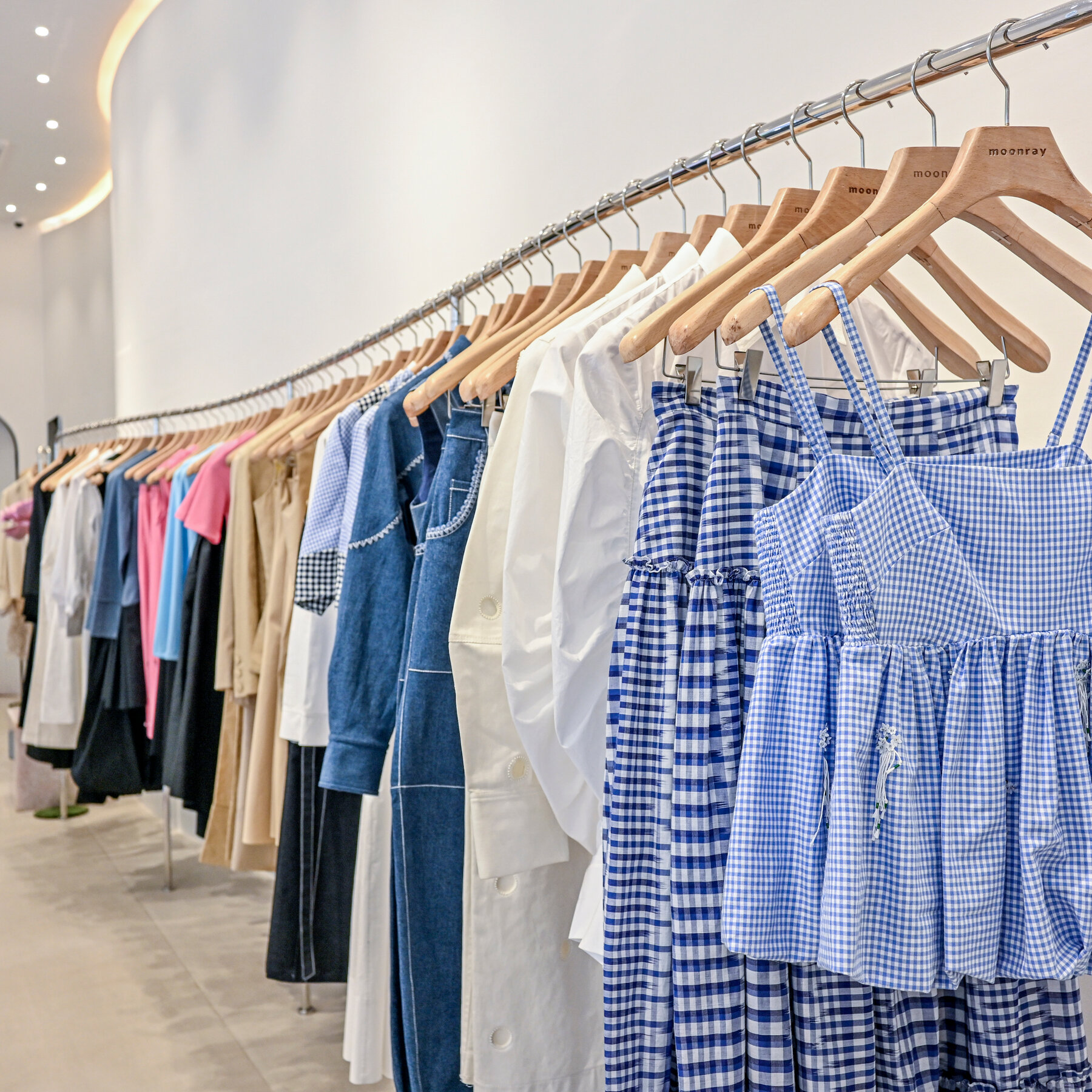
Moonray
Stroll the Kala Ghoda neighborhood, starting with Artisans’, a gallery and shop in a graffiti-covered building that showcases traditional Indian crafts. In the area’s ever-expanding fashion district, browse crisp white shirts with handmade lace collars (from around 9,500 rupees) at Moonray, a women’s fashion label and shop (its co-founder also runs the Chanakya School of Craft, which teaches women embroidery and collaborates with Dior). Also check out Payal Khandwala, which has silk tops (14,000 rupees), sharply cut suits and trench coats in bold-colored Indian fabric, and Ogaan, with heavily embellished wedding dresses, pleated dresses and more. Then walk to Kitab Khana, an independent bookstore in a more-than-century-old building with Corinthian columns in the nearby Fort district. Browse the well-curated selection of Indian literature and the books on history and Gandhian thought that line the high shelves.

Moonray
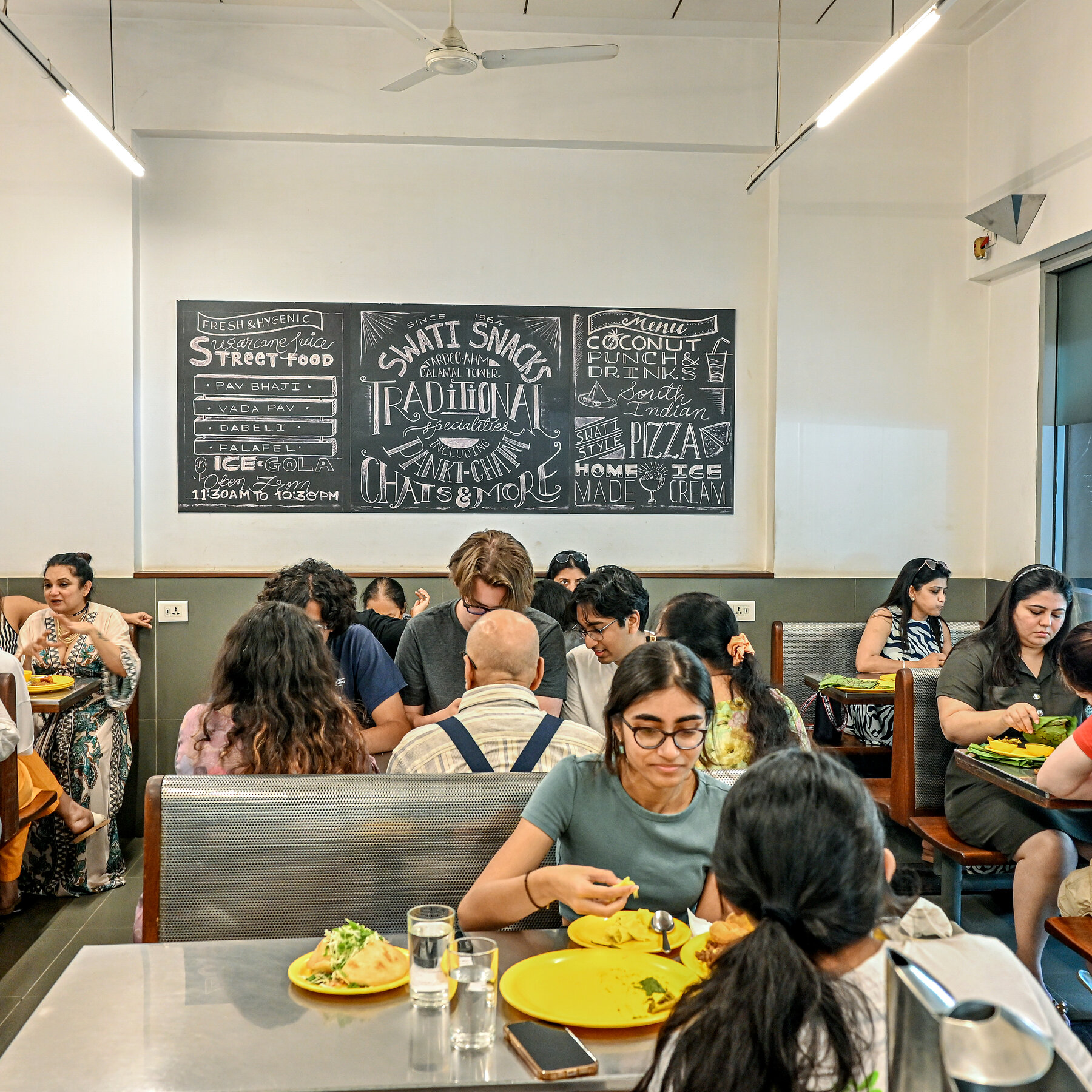
Swati Snacks
A dizzying range of delicacies can be found on Mumbai’s khao gallis, a Hindi term for “food streets.” The safest way to try them all (and avoid tummy trouble) might be at Swati Snacks, a six-decade-old restaurant in the Tardeo area. Have the vada pav (175 rupees), like garlicky potato sliders, and the signature panki (230 rupees), a wispy rice pancake flavored with mint or dill that arrives steaming in a banana-leaf parcel. Then visit the nearby Mani Bhavan, a three-story building where Mohandas K. Gandhi, known as the father of the nation, often stayed; it is now a museum. Spinning wheels and floor seating in his preserved, spartan bedroom provide a window to his belief that the route to Indian independence could come only through discipline and self-reliance. Entry, 20 rupees.

Swati Snacks
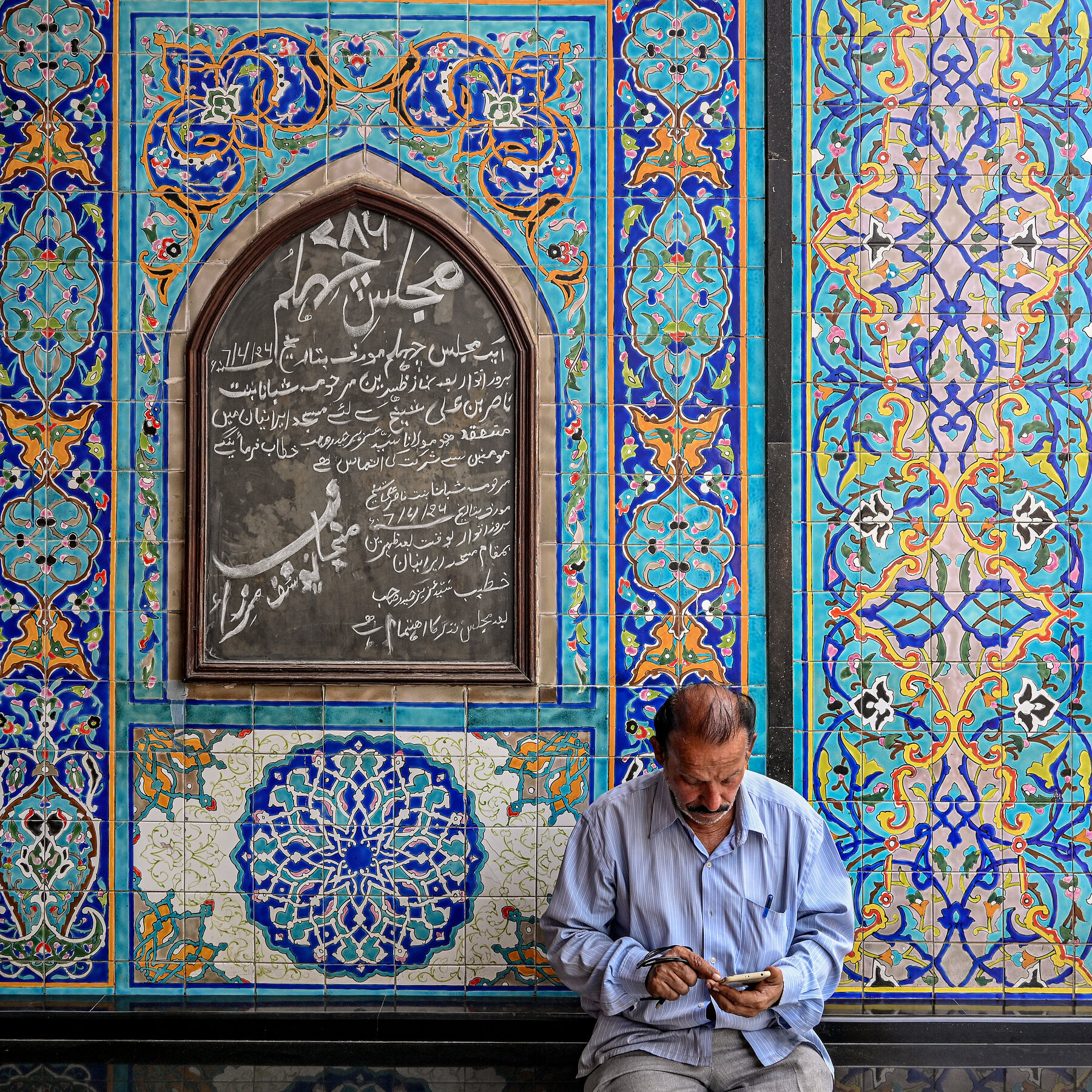
Moghal Masjid
Take a car to Byculla, the chaotic old quarter of Mumbai. Get a coffee (Americano, 228 rupees) at the Craftery by Subko, a new Mumbai cafe and roastery chain bringing hipsters to this part of the city. Then drive through the busy, narrow streets to see some of Mumbai’s diverse and beautiful religious monuments. Visit the nearby Moghal Masjid, a jewel-like, Iranian-style Shiite mosque built in 1860, with intricate blue tiling adorning a curved entrance. Women cannot pray inside the mosque but can enter the compound, which has a pool for ablution. Take in the facade of Hasnabad Dargah, a pristine, ivory-colored mausoleum, known as Mumbai’s Taj Mahal for its resemblance to the original (entry only for Shia Ismaili Muslims). Not far from there is the Magen David Synagogue (entry, 300 rupees), recognizable by its sky blue clock tower, built in the 1860s to serve Mumbai’s once wealthy and influential, but now vanishing, Jewish community.

Moghal Masjid

Bastian at the Top
In the Dadar neighborhood, shop for handwoven saris (from 2,000 rupees) and scarves at Induri Saree Centre, a candy-box-size store. Then line up at Aaswad Upahar and Mithai Griha, a no-frills Dadar institution best visited in April and May with the arrival of fragrant and luscious Alphonso mangoes. Aaswad does a seasonal mango-themed thali (a platter of various small dishes; 470 rupees) that includes a saffron, mango and cardamom drink; a mango dal; and chilled mango pulp called aamras that is the taste of a Mumbai summer in a bowl. Then cross the street to the gleaming, new Kohinoor Square mall and take the elevator 48 floors to Bastian at the Top. With a tree-lined plunge pool and glowing figurines carved into giant pillars, it can feel more like a theme park than a restaurant (it often attracts Bollywood celebrities). It’s worth a cocktail (1,295 rupees) just to take in the sweeping views of the bay.

Bastian at the Top
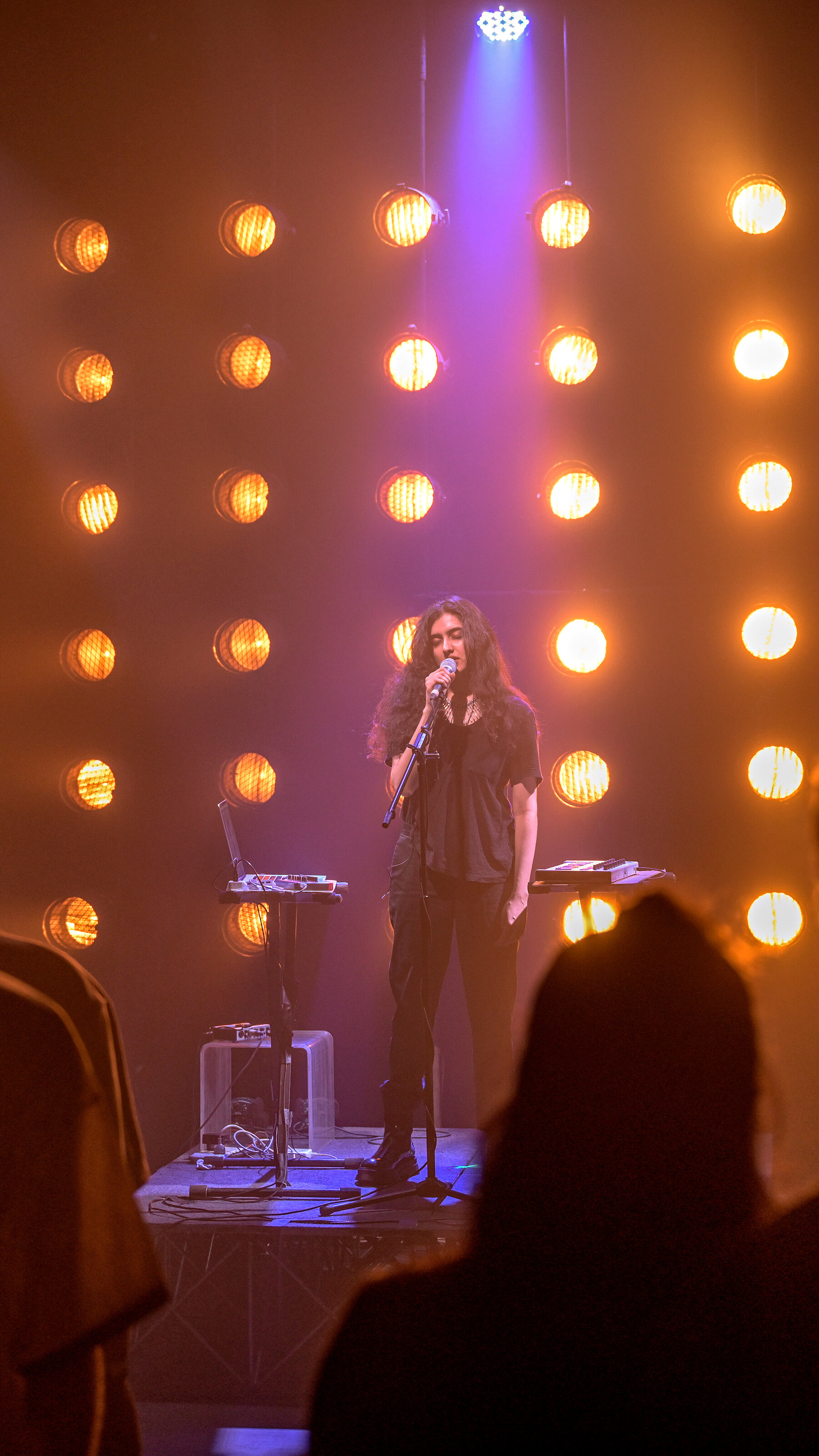
Catch a show at G5A, a cultural center housed in a repurposed textile mill compound.
Sunday
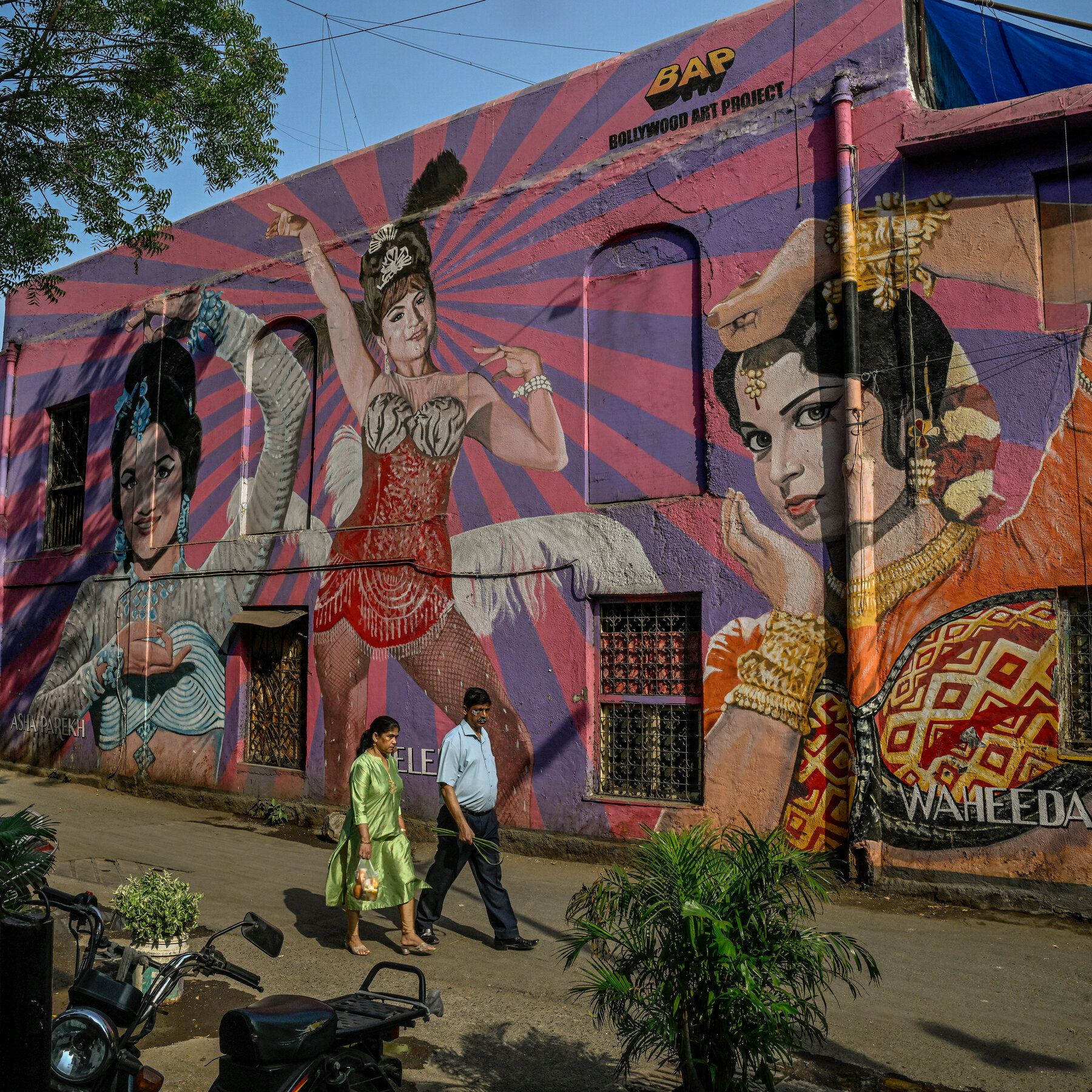
A mural by Ranjit Dahiya
The laid-back suburb of Bandra has Portuguese bungalows, Bollywood studios and the full wattage of star homes along with fans hoping for a glimpse. The best bet for encountering Bollywood stars is on the Technicolor, larger-than-life murals in the area’s charming lanes. See a pistol-wielding Dharmendra, from the iconic 1975 movie “Sholay,” opposite the Subko cafe on Chapel Road. Next to it is a triptych of Bollywood’s dancing divas — a feathered Helen and a bejeweled Waheeda Rehman and Asha Parekh. (Ranjit Dahiya, the artist behind many of these murals, also teaches workshops.) Stroll on to Waroda Road (past a moody depiction of the celebrated actor Irrfan Khan) to reach the brightly colored Veronica’s, an all-day cafe that has become something of a living room for Bandra’s young set, who come for creative bites like chicken-and-cheese-filled breakfast momos (395 rupees), potato waffles (350 rupees) and babka stuffed with chorizo (275 rupees).

A mural by Ranjit Dahiya
Leave the chaos of the city behind, driving north to reach the entrance of Sanjay Gandhi National Park, a 40-square-mile preserve where deer, monkeys and the occasional leopard roam. From inside the park, minivans drive visitors about 10 minutes through the forest (1,000 rupees round-trip) to the bottom of a hill. From there, walk up to the Kanheri Caves, a Buddhist complex of more than 100 caves, the oldest dating back 2,000 years, carved into basalt. Some form large, pillared prayer halls, while others feature carved serene Buddhist deities in prayer. Also see the waterways, loosely cut into the hills, that provided water to the monks who lived and meditated there many centuries ago. Park entry, 95 rupees; caves entry, 25 rupees.